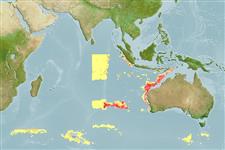Élasmobranches (requins et raies) (sharks and rays) >
Squaliformes (Sleeper and dogfish sharks) >
Etmopteridae (Lantern sharks)
Etymology: Etmopterus: Greek, ethmos, -ou = sieve or ethmoides bone + Greek, pteron = wing, fin (Ref. 45335); fusus: Named for its fusiform body resembling a naval torpedo.
More on authors: Last, Burgess & Séret.
Environment: milieu / climate zone / profondeur / distribution range
Écologie
marin pelagic-oceanic; profondeur 430 - 550 m (Ref. 45056). Deep-water
Eastern Indian Ocean: northern Western Australia and possibly Java, Indonesia.
Taille / Poids / Âge
Maturité: Lm ? range ? - ? cm
Max length : 25.8 cm TL mâle / non sexé; (Ref. 45056); 29.3 cm TL (female)
Description synthétique
Clés d'identification | Morphologie | Morphométrie
Vertèbres: 77 - 81. Body firm fusiform, almost cylindrical. Dorsal and ventral surfaces dark; pectoral fin pale distally. Head relatively long (> 21% TL). Mouth moderate, subequal to eye length. Upper eyelid with pale naked patch. Caudal peduncle rather elongate, ca 2-2.6 times greatest horizontal length of D1 including spine about a 5th of TL. Upper teeth of mature males with 7 cusps. Denticles short, robust, arranged in regular rows. Posterior branch of flank marking truncate and merging ventrally with post-pelvic marking. Anterior part of caudal base marking very broad, enveloping ventral surface and extending onto flanks; presence of oval central caudal marking; upper caudal marking comma-shaped. Monospondylous centra 36-38 (Ref. 45056).
Body shape (shape guide): elongated; Cross section: oval.
Ovoviviparous (Ref. 205).
Life cycle and mating behavior
Maturité | Reproduction | Frai | Œufs | Fécondité | Larves
Distinct pairing with embrace (Ref. 205).
Last, P., G.H. Burgess and B. Séret, 2002. Description of six new species of lantern-sharks of the genus Etmopterus (Squaloidea: Etmopteridae) from the Australasian region. Cybium 26(3):203-223. (Ref. 45056)
Statut dans la liste rouge de l'IUCN (Ref. 130435: Version 2025-1)
Menace pour l'homme
Harmless
Utilisations par l'homme
Pêcheries: sans intérêt
Outils
Articles particuliers
Télécharger en XML
Sources Internet
Estimates based on models
Preferred temperature (Réf.
123201): 8 - 9.6, mean 8.3 °C (based on 7 cells).
Phylogenetic diversity index (Réf.
82804): PD
50 = 0.5000 [Uniqueness, from 0.5 = low to 2.0 = high].
Bayesian length-weight: a=0.00380 (0.00194 - 0.00745), b=3.09 (2.92 - 3.26), in cm total length, based on LWR estimates for this Genus-body shape (Ref.
93245).
Niveau trophique (Réf.
69278): 4.0 ±0.5 se; based on size and trophs of closest relatives
Résilience (Réf.
120179): Faible, temps minimum de doublement de population : 4,5 à 14 années (Fec assumed to be <100).
Fishing Vulnerability (Ref.
59153): Low vulnerability (19 of 100).
🛈
